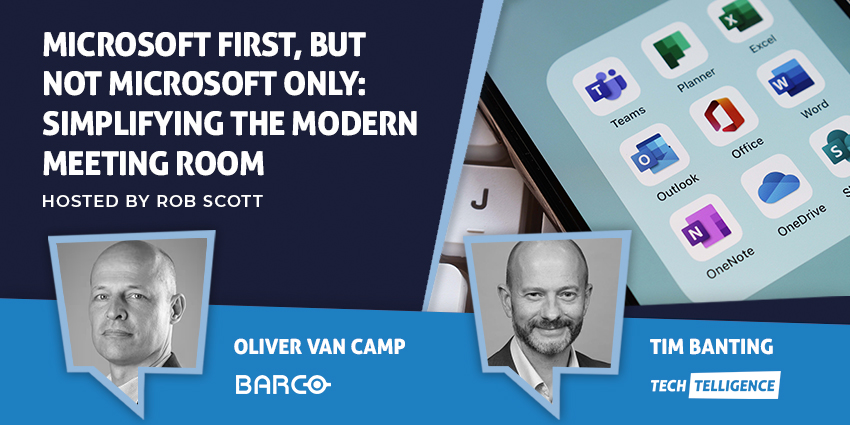“AI is a gamechanger in our market,” said Gary Kayye, Co-founder & Director at THE rAVe Agency, in his opening statement of Yealink’s ISE Tech Talk earlier this month.
The talk, appropriately titled “Innovation Unveiled,” focused on how AI use cases have evolved in the meeting space over the past couple of years and shed light on Yealink’s role in this evolution, along with its strategic partnerships with Microsoft and Qualcomm.
While we’re all quite used to AI enhancing audio and video quality in remote and hybrid meetings, as well as transcribing—and even translating—spoken content, the future of AI will go above and beyond the previous stages. The expected levels of personalization and immersion will also require a shift in the way AI deployment—transitioning from cloud-based to edge-based AI.
From trends and developments to partnerships and a brand-new product launch, here’s a quick review of primary themes from Yealink’s recent talk.
AI for Meetings: A New Era of Technology Trends
Dawson Cai, VP Product at Yealink, mentioned two prominent AI-powered trends regarding intelligent meeting room cameras and how they manifest in Microsoft Teams Rooms (MTR) solutions.
“The MTR market is truly entering a new era, where customers must make sure any solutions that they choose are future proof,” he noted.
Cai pinpointed the following trends:
- One Camera, More Lenses: Modern cameras feature multiple lenses, as seen in Yealink’s latest products, which integrate three or four lenses to stitch a better image. This enables a wider angle and greater range, ensuring even distant participants appear in high quality.
- One Room, More Cameras: Even with multiple lenses, a single camera captures only one angle. But in today’s hybrid meetings—particularly in larger spaces—participants engage with both remote attendees and in-room colleagues. This shift requires a multi-camera setup.
With more lenses and cameras, stitching images, tracking speakers, selecting cameras, and switching seamlessly become more complex, inevitably increasing reliance on advanced AI capabilities.
Beyond Meetings: AI as a Proactive Participant
Albert Kooiman, Senior Director of Microsoft Teams Partner Engineering and Customer Experiences, shared plans to leverage AI in the Teams platform, highlighting its evolution from a tool that enhances video and audio to an active, decision-making participant.
“In 2025, we’re working on allowing users to be assisted by Copilot in understanding what truly went on in the meeting room,” he said.
Beyond transcription and translation, users will be able to ask Copilot for sentiment analysis, summaries, and key takeaways.
The next stage is Microsoft’s Facilitator Agent, which will proactively manage meetings. It will set agendas, track action items in real time, and remind participants of pending topics before the meeting ends.
Looking ahead, Kooiman noted, AI won’t just organize tasks—it will act as a Chief of Staff, advising on priorities and even attending meetings on a user’s behalf.
Future-Proof AI: Powerful Processors Drive Immersive UX
Delivering an AI-powered, immersive meeting experience requires cutting-edge processing—something cloud-based AI alone can’t achieve in real-time. This is where edge AI technology plays a crucial role.
Sidharth Franco Agarwaal, Director of Business Development at Qualcomm, explained that advanced AI algorithms are essential for detecting speakers, tracking movement, and optimizing video quality. With multi-camera setups and evolving Gen AI capabilities, the demand for high-performance on-device processing has never been greater.
Yealink’s latest multi-camera solutions rely on Qualcomm processors, “integrating CPU, GPU, AI DSP, and audio DSP to ensure an optimized experience across all areas,” Agarwaal explained.
AV ONE: AI for Simplified Design & Deployment
To conclude, Yealink introduced for the first time their AV ONE solution, a “one-stop solution for Pro-AV rooms.”
Designed for effortless deployment, AV ONE automates smart room design, optimizing configurations based on room size and equipment needs. Fully integrated with Microsoft Teams Rooms, it dynamically adjusts AV settings for a seamless conferencing experience. Its scalable AVoIP deployment transmits high-quality audio and video over standard IP networks, simplifying cabling and centralizing IT management—all while ensuring compatibility with industry standards like Dante/AES67.
“In two words, we make Pro-AV smart and simple,” Cai concluded. “We’ll continue to use this philosophy to create products, regardless of room size.”
AV ONE is expected to become available for purchase in June 2025. Stay tuned!







